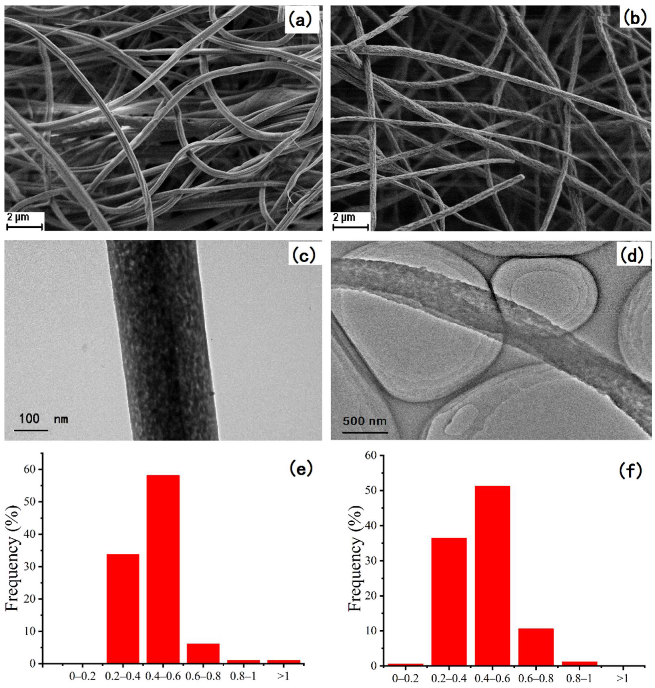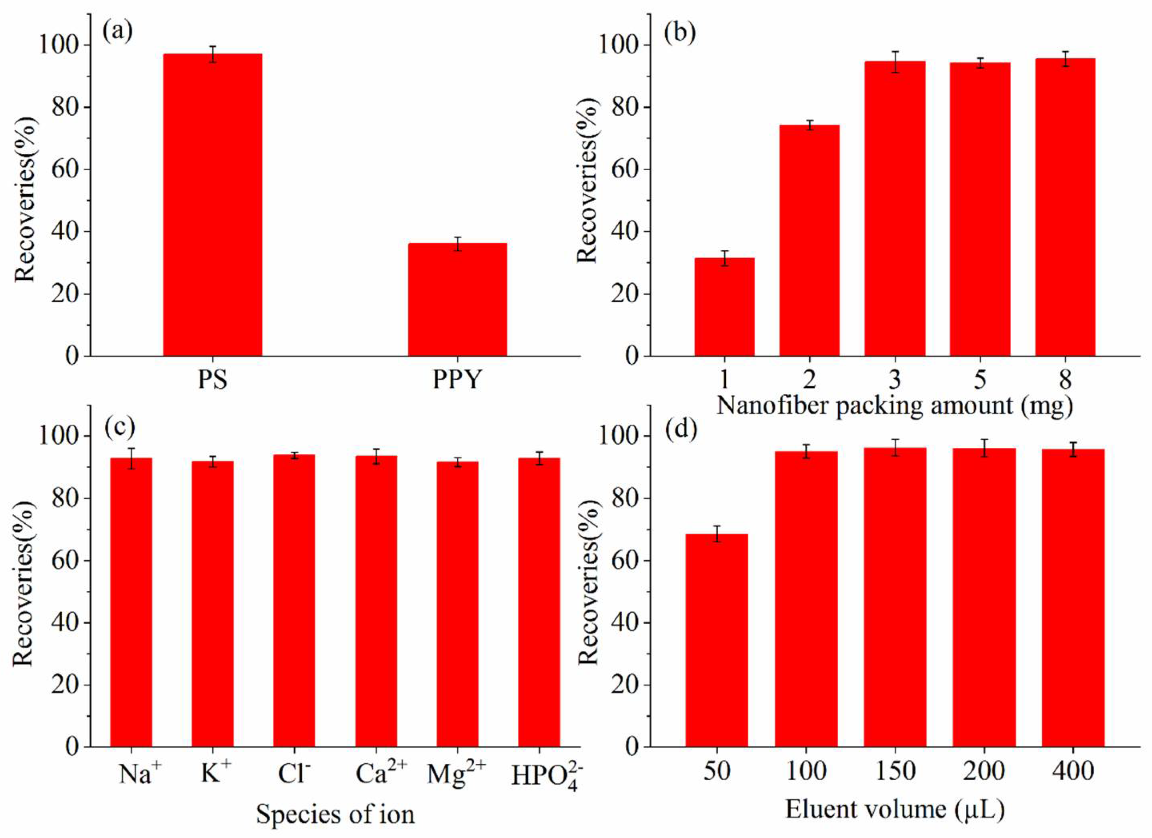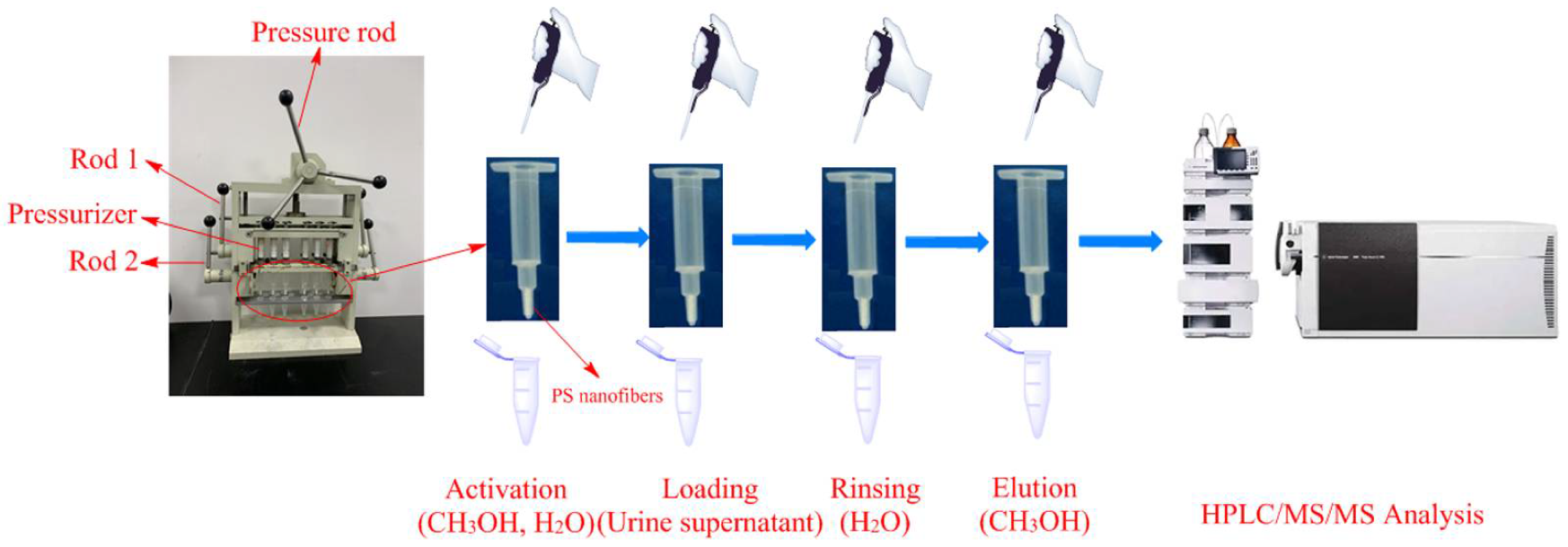Packed-Fiber Solid Phase-Extraction Coupled with HPLC-MS/MS for Rapid Determination of Lipid Oxidative Damage Biomarker 8-Iso-Prostaglandin F2α in Urine
Abstract
:1. Introduction
2. Results and Discussion
2.1. Morphological Characterization of Nanofibers
2.2. Optimization of PFSPE Conditions
2.2.1. Comparison between PS and PS/PPY Nanofibers
2.2.2. Nanofibers Packing Amount
2.2.3. Species of Ion
2.2.4. Volume of Eluent
2.3. Method Validation
2.3.1. Linearity and Sensitivity
2.3.2. Precision and Recovery
2.3.3. Matrix Effect
2.4. Comparison with Other Methods
2.5. Application to Real Samples
3. Materials and Methods
3.1. Chemicals and Reagents
3.2. Fabrication of PS and PS/PPY Nanofibers
3.3. Sample Collection
3.4. Sample Pretreatment and PFSPE Procedures
3.5. HPLC-MS/MS Analysis
4. Conclusions
Supplementary Materials
Author Contributions
Funding
Institutional Review Board Statement
Informed Consent Statement
Data Availability Statement
Conflicts of Interest
Sample Availability
References
- Kadiiska, M.B.; Gladen, B.C.; Baird, D.D.; Germolec, D.; Graham, L.B.; Parker, C.E.; Nyska, A.; Wachsman, J.T.; Ames, B.N.; Basu, S.; et al. Biomarkers of oxidative stress study II: Are oxidation products of lipids, proteins, and DNA markers of CCl4 poisoning? Free Radic. Biol. Med. 2005, 38, 698–710. [Google Scholar] [CrossRef] [PubMed]
- Van ’t Erve, T.J.; Lih, F.B.; Kadiiska, M.B.; Deterding, L.J.; Eling, T.E.; Mason, R.P. Reinterpreting the best biomarker of oxidative stress: The 8-iso-PGF(2alpha)/PGF(2alpha) ratio distinguishes chemical from enzymatic lipid peroxidation. Free Radic. Biol. Med. 2015, 83, 245–251. [Google Scholar] [CrossRef] [PubMed] [Green Version]
- Leitinger, N.; Blazek, I.; Sinzinger, H. The generation and actions of isoprostanes. Thromb. Res. 1997, 86, 337–342. [Google Scholar] [CrossRef]
- Morrow, J.D.; Harris, T.; Roberts, L.J. Noncyclooxygenase oxidative formation of a series of novel prostaglandins—Analytical ramifications for measurement of eicosanoids. Anal. Biochem. 1990, 184, 1–10. [Google Scholar] [CrossRef]
- Yin, H.; Xu, L.; Porter, N.A. Free radical lipid peroxidation: Mechanisms and analysis. Chem. Rev. 2011, 111, 5944–5972. [Google Scholar] [CrossRef] [PubMed]
- Yin, H.; Porter, N.A.; Morrow, J.D. Separation and identification of F2-isoprostane regioisomers and diastereomers by novel liquid chromatographic/mass spectrometric methods. J. Chromatogr. B Anal. Technol. Biomed. Life Sci. 2005, 827, 157–164. [Google Scholar] [CrossRef]
- Montuschi, P.; Barnes, P.J.; Roberts, L.J., II. Isoprostanes: Markers and mediators of oxidative stress. FASEB J. 2004, 18, 1791–1800. [Google Scholar] [CrossRef]
- Roberts, L.J., II; Milne, G.L. Isoprostanes. J. Lipid Res. 2009, 50, S219–S223. [Google Scholar] [CrossRef] [Green Version]
- Dalle-Donne, I.; Rossi, R.; Colombo, R.; Giustarini, D.; Milzani, A. Biomarkers of oxidative damage in human disease. Clin. Chem. 2006, 52, 601–623. [Google Scholar] [CrossRef]
- Basu, S. F2-isoprostanes in human health and diseases: From molecular mechanisms to clinical implications. Antioxid. Redox Signal. 2008, 10, 1405–1434. [Google Scholar] [CrossRef]
- Roberts, L.; Morrow, J. Measurement of F2-isoprostanes as an index of oxidative stress in vivo. Free Radic. Biol. Med. 2000, 28, 505–513. [Google Scholar] [CrossRef]
- Milne, G.L.; Dai, Q.; Roberts, L.J., II. The isoprostanes—25 years later. Biochim. Biophys. Acta 2015, 1851, 433–445. [Google Scholar] [CrossRef] [PubMed] [Green Version]
- Morrow, J.D.; Hill, K.; Burk, R.; Nammour, T.; Badr, K.; Roberts, L. A series of prostaglandin F2-like compounds are produced in vivo in humans by a non-cyclooxygenase, free radical-catalyzed mechanism. Proc. Natl. Acad. Sci. USA 1990, 87, 9383–9387. [Google Scholar] [CrossRef] [PubMed] [Green Version]
- Basu, S. Bioactive eicosanoids: Role of prostaglandin F(2alpha) and F(2)-isoprostanes in inflammation and oxidative stress related pathology. Mol. Cells 2010, 30, 383–391. [Google Scholar] [CrossRef] [PubMed]
- Gopaul, N.K.; Halliwell, B.; Anggard, E.E. Measurement of plasma F2-isoprostanes as an index of lipid peroxidation does not appear to be confounded by diet. Free Radic. Res. 2000, 33, 115–127. [Google Scholar] [CrossRef]
- Janssen, L. Isoprostanes:an overview and putative roles in pulmonary pathophysiology. Am. J. Physiol. 2001, 280, L1067–L1082. [Google Scholar] [CrossRef] [Green Version]
- Duchene, B.; Caffry, S.; Kaminsky, D.A.; Que, L.G.; Poynter, M.E.; Dixon, A.E. Functional significance of 8-isoprostanes in sinonasal disease and asthma. Respir. Med. 2021, 185, 106506. [Google Scholar] [CrossRef]
- Ferre-Gonzalez, L.; Pena-Bautista, C.; Baquero, M.; Chafer-Pericas, C. Assessment of Lipid Peroxidation in Alzheimer’s Disease Differential Diagnosis and Prognosis. Antioxidants 2022, 11, 551. [Google Scholar] [CrossRef]
- Proudfoot, J.; Barden, A.; Mori, T.; Burke, V.; Croft, K.; Beilin, L.; Puddey, I. Measurement of urinary F-2,-isoprostanes as markers of in vivo lipid peroxidation—A comparison of enzyme immunoassay with gas chromatography_mass spectrometry. Anal. Biochem. 1999, 272, 209–215. [Google Scholar] [CrossRef]
- Wiswedel, I. F(2)-isoprostanes: Sensitive biomarkers of oxidative stress in vitro and in vivo: A gas chromatography-mass spectrometric approach. Methods Mol. Biol. 2009, 580, 3–16. [Google Scholar] [CrossRef]
- Biagini, D.; Antoni, S.; Lomonaco, T.; Ghimenti, S.; Salvo, P.; Bellagambi, F.G.; Scaramuzzo, R.T.; Ciantelli, M.; Cuttano, A.; Fuoco, R.; et al. Micro-extraction by packed sorbent combined with UHPLC-ESI-MS/MS for the determination of prostanoids and isoprostanoids in dried blood spots. Talanta 2020, 206, 120236. [Google Scholar] [CrossRef] [PubMed]
- Smith, K.A.; Shepherd, J.; Wakil, A.; Kilpatrick, E.S. A comparison of methods for the measurement of 8-isoPGF(2alpha): A marker of oxidative stress. Ann. Clin. Biochem. 2011, 48, 147–154. [Google Scholar] [CrossRef] [PubMed]
- Morrow, J.D.; Frei, B.; Longmire, A.W.; Gaziano, J.M.; Lynch, S.M.; Shyr, Y.; Strauss, W.E.; Oates, J.A.; Roberts, L.J. Increase in circulating products of lipid-peroxidation (F-2-Isoprostanes) in smokers—smoking as a cause of oxidative damage. N. Engl. J. Med. 1995, 332, 1198–1203. [Google Scholar] [CrossRef] [PubMed]
- Sircar, D.; Subbaiah, P.V. Isoprostane measurement in plasma and urine by liquid chromatography-mass spectrometry with one-step sample preparation. Clin. Chem. 2007, 53, 251–258. [Google Scholar] [CrossRef]
- Tomov, D.G.; Bocheva, G.; Divarova, V.; Kasabova, L.; Svinarov, D. Phase separation liquid-liquid extraction for the quantification of 8-iso-Prostaglandin F2 Alpha in human plasma by LC-MS/MS. J. Med. Biochem. 2021, 40, 10–16. [Google Scholar] [CrossRef]
- Decramer, S.; de Peredo, A.G.; Breuil, B.; Mischak, H.; Monsarrat, B.; Bascands, J.-L.; Schanstra, J.P. Urine in Clinical Proteomics. Mol. Cell. Proteom. 2008, 7, 1850–1862. [Google Scholar] [CrossRef] [Green Version]
- Sun, Y.; Xie, L.; Feng, F.; Han, Q.; Wei, L.; Tang, Z.; Kang, X. Simultaneous analysis of two urinary biomarkers of oxidative damage to DNA and RNA based on packed-fiber solid phase extraction coupled with high-performance liquid chromatography. J. Chromatogr. B Anal. Technol. Biomed. Life Sci. 2020, 1159, 122358. [Google Scholar] [CrossRef]
- Zhao, R.; Chu, L.; Wang, Y.; Song, Y.; Liu, P.; Li, C.; Huang, J.; Kang, X. Application of packed-fiber solid-phase extraction coupled with GC–MS for the determination of short-chain fatty acids in children’s urine. Clin. Chim. Acta 2017, 468, 120–125. [Google Scholar] [CrossRef]
- Im, E.; Lew, B.L.; Lee, M.Y.; Lee, J.; Paeng, K.J.; Chung, B.C. Simultaneous determination of androgens and prostaglandins in human urine using ultra-high-performance liquid chromatography-tandem mass spectrometry. J. Chromatogr. B Anal. Technol. Biomed. Life Sci. 2019, 1109, 45–53. [Google Scholar] [CrossRef]
- Martinez-Moral, M.P.; Kannan, K. Analysis of 19 urinary biomarkers of oxidative stress, nitrative stress, metabolic disorders, and inflammation using liquid chromatography-tandem mass spectrometry. Anal. Bioanal. Chem. 2022, 414, 2103–2116. [Google Scholar] [CrossRef]
- Maenne, M.J.; Shaw, K.A.; Bakian, A.V.; Bilder, D.A.; Durkin, M.S.; Esler, A. Prevalence and Characteristics of Autism Spectrum Disorder Among Children Aged 8 Years-Autism and Developmental Disabilities Monitoring Network, 11 Sites, United States, 2018. Surveill. Summ. 2021, 70, 1–16. [Google Scholar] [CrossRef] [PubMed]
- China Mohotpsro. Urine—Determination of creatinine—Reversed-phase High Performance Liquid Chromatographic Method; China Mohotpsro: Beijing, China, 1997; WS_T 98-1996.
- Bjorklund, G.; Meguid, N.A.; El-Bana, M.A.; Tinkov, A.A.; Saad, K.; Dadar, M.; Hemimi, M.; Skalny, A.V.; Hosnedlova, B.; Kizek, R.; et al. Oxidative Stress in Autism Spectrum Disorder. Mol. Neurobiol. 2020, 57, 2314–2332. [Google Scholar] [CrossRef] [PubMed]
- Kang, X.; Pan, C.; Xu, Q.; Yao, Y.; Wang, Y.; Qi, D.; Gu, Z. The investigation of electrospun polymer nanofibers as a solid-phase extraction sorbent for the determination of trazodone in human plasma. Anal. Chim. Acta 2007, 587, 75–81. [Google Scholar] [CrossRef] [PubMed]
- Tian, T.; Deng, J.; Xie, Z.; Zhao, Y.; Feng, Z.; Kang, X.; Gu, Z. Polypyrrole hollow fiber for solid phase extraction. Analyst 2012, 137, 1846. [Google Scholar] [CrossRef]




| Nanofibers | BET Surface Area (m2/g) | Pore Volume (cm3/g) | Pore Size (nm) |
|---|---|---|---|
| PS | 18.72 | 0.18 | 39.33 |
| PS/PPY | 15.40 | 0.11 | 28.04 |
| Analyte | Linear Range (ng/mL) | R2 | LOD (ng/mL) | LOQ (ng/mL) | Spiked Concentration (ng/mL) | RSD (%) | Recovery (%) | |
|---|---|---|---|---|---|---|---|---|
| Intra-Day | Inter-Day | |||||||
| 8-iso-PGF2α | 0.05–5 | 0.9996 | 0.015 | 0.05 | 0.05 | 8.4 | 9.2 | 103.8 ± 9.3 |
| 0.5 | 5.3 | 6.8 | 97.5 ± 4.9 | |||||
| 5 | 2.1 | 4.7 | 95.3 ± 4.8 | |||||
| Adsorbent | Adsorbent Amount (mg) | Size | Specific Surface Area (m2/g) | Pore Size (nm) | Pore Volume (cm3/g) | Evaporation | Recovery (%) |
|---|---|---|---|---|---|---|---|
| PS nanofibers | 3 | 500 nm | 18.72 | 39.33 | 0.18 | NO | 102.4 |
| HLB * | 60 | 28.3 µm | 808 | 8.3 | 1.31 | YES | 78.7 |
| Method | Sample | Sample Amount (µL) | Sample Preparation | Pretreatment Time | Organic Solvent (mL) | LOD (ng/mL) | Recovery (%) | Evaporation | Ref. |
|---|---|---|---|---|---|---|---|---|---|
| HPLC-MS/MS | Plasma, urine | 300 | Hydrolysis, immunoaffinity column | >60 min | >2 | 0.0005 | 78–102, 75–99 | YES | [24] |
| UHPLC-MS/MS | Dried blood spots | 50 | Packed sorbent silica-C18 Barrel Insert and Needles | >5 h for spot dry, 10 min for SPE | 0.58 | 0.015 | 89.1–109.5 | YES | [21] |
| HPLC-MS/MS | Plasma | 500 | LLE | >1 h | >4 | - | 59.2–68.5 | YES | [25] |
| UHPLC-MS/MS | Urine | 100 | SPE (OASIS HLB *), Incubation, derivatization, LLE | >3.5 h | >8 | - | 101.4 | YES | [29] |
| HPLC-MS/MS | Urine | 500 | Incubation, derivatization, SPE (ABS ElutNexus **) | >30 min | >4 | 0.013 | - | YES | [30] |
| HPLC-MS/MS | Urine | 1000 | PFSPE (PS nanofibers) | ≈5 min | 0.2 | 0.015 | 92.3–104.9 | NO | this study |
| Compound | Quantitative Ion (m/z) | CE (V) | Retention Time (min) |
|---|---|---|---|
| 8-iso-PGF2α | 353.2→309.1 | 14 | 4.22 |
| 353.2→193 | 22 | ||
| 8-iso-PGF2α-d4 | 357.2→197.2 | 22 | 4.16 |
Publisher’s Note: MDPI stays neutral with regard to jurisdictional claims in published maps and institutional affiliations. |
© 2022 by the authors. Licensee MDPI, Basel, Switzerland. This article is an open access article distributed under the terms and conditions of the Creative Commons Attribution (CC BY) license (https://creativecommons.org/licenses/by/4.0/).
Share and Cite
Sun, Y.; Yan, Y.; Kang, X. Packed-Fiber Solid Phase-Extraction Coupled with HPLC-MS/MS for Rapid Determination of Lipid Oxidative Damage Biomarker 8-Iso-Prostaglandin F2α in Urine. Molecules 2022, 27, 4417. https://doi.org/10.3390/molecules27144417
Sun Y, Yan Y, Kang X. Packed-Fiber Solid Phase-Extraction Coupled with HPLC-MS/MS for Rapid Determination of Lipid Oxidative Damage Biomarker 8-Iso-Prostaglandin F2α in Urine. Molecules. 2022; 27(14):4417. https://doi.org/10.3390/molecules27144417
Chicago/Turabian StyleSun, Ying, Yan Yan, and Xuejun Kang. 2022. "Packed-Fiber Solid Phase-Extraction Coupled with HPLC-MS/MS for Rapid Determination of Lipid Oxidative Damage Biomarker 8-Iso-Prostaglandin F2α in Urine" Molecules 27, no. 14: 4417. https://doi.org/10.3390/molecules27144417






